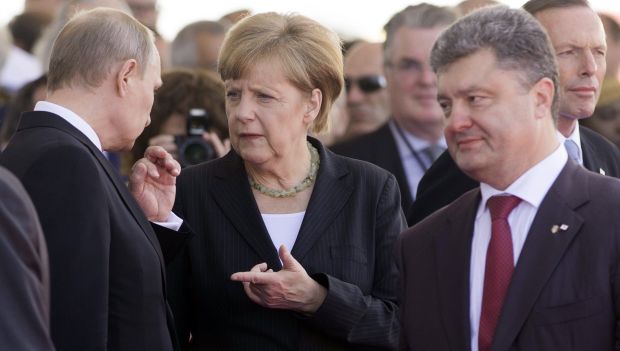
German Chancellor Angela Merkel speaks with Russian President Vladimir Putin (L) as Ukraine’s President-elect Petro Poroshenko (R) walks past during the Ouistreham International Ceremony at Sword Beach to commemorate the 70th anniversary of the Allied invasion at Normandy, in Ouistreham, France, June 6, 2014. (AFP PHOTO/SAUL LOEB)
Kiev, Reuters—German Chancellor Angela Merkel flew in to the Ukrainian capital on Saturday and said she wanted to help end a crisis over Ukraine which flared again after Russia sent a convoy of trucks into Ukraine without Kiev’s permission.
Many of the trucks had crossed back into Russia, helping ease the tension sparked by what Western governments said was the convoy’s illegal incursion a day earlier.
Making her first visit to Ukraine since the conflict broke out four months ago in the east of the country between pro-Moscow separatists and government forces, Merkel went into talks with Ukrainian President Petro Poroshenko.
In brief remarks at the start of their talks, the German leader said she came to Kiev “in a difficult time which is focussed on the unity and territorial integrity of Ukraine.”
“I hope that we will be able to discuss bilateral problems and support from Germany as well as the path towards peace, which must be found,” she said.
Hours before her plane landed in Kiev, there was heavy artillery bombardment in Donetsk, the main separatist stronghold on the east of Ukraine, near the border with Russia. Reuters reporters saw apartments destroyed and puddles of blood, where, according to residents, two civilians were killed.
The unusually intense shelling may be part of a drive by government forces to achieve a breakthrough against the rebels in time for Ukrainian Independence Day, which falls on Sunday.
Diplomats say Merkel has two aims for the visit: primarily to show support for Kiev in its stand-off with Russia, but also urge Poroshenko to be open to peace proposals when he meets Russian President Vladimir Putin for talks next week.
A convoy of about 220 white-painted trucks rolled into Ukraine on Friday through a border crossing controlled by the rebels after days waiting for clearance.
Moscow said the trucks moved in without Kiev’s consent because civilians in areas under siege from Ukrainian government troops were in urgent need of food, water and other supplies.
Russian state television broadcast footage of some of the trucks being unloaded at a distribution depot in the city of Luhansk, eastern Ukraine, where beleaguered rebels are trying to hold of an offensive by government troops.
Kiev called the convoy a direct invasion, a stance echoed by NATO, the United States, and European leaders.
A Reuters journalist at the Donetsk-Izvaryne border crossing, where the convoy rolled into Ukraine on Friday, said trucks on Saturday had started pouring back onto the Russian side of the border.
The foreign ministry in Moscow said the convoy had now left Ukraine, though a Ukrainian military spokesman disputed this, saying only 184 of the 220 vehicles had re-entered Russia.
The spokesman, Andriy Lysenko, also alleged that the aid trucks had been loading up with equipment removed from Ukrainian armaments factories in rebel-held territory. This could not be independently verified.
In Brussels, NATO said it had reports that Russian troops had been firing artillery at Kiev’s forces inside Ukraine – fuelling Western allegations that the Kremlin is behind the conflict in an effort undermine the Western-leaning leadership in Kiev.
“Since mid-August we have multiple reports of the direct involvement of Russian forces, including airborne, air defence and special operations forces in Eastern Ukraine,” said NATO spokeswoman Oana Lungescu.
“Russian artillery support – both cross border and from within Ukraine – is being employed against the Ukrainian armed forces,” she said.
The Russian foreign ministry, in a statement, called those allegations “groundless.” Russia accuses Kiev, with the backing of the West, of waging a war against innocent civilians in eastern Ukraine, a mainly Russian-speaking region.
The conflict in Ukraine has dragged Russian-Western relations to their lowest ebb since the Cold War and sparked a round of trade sanctions that are hurting already-fragile economies in European and Russia.
The crisis over Ukraine started when mass protests in Kiev ousted a president who was close to Moscow, and instead installed leaders viewed with suspicion by the Kremlin.
Soon after that, Russia annexed the Ukrainian region of Crimea, and a separatist rebellion broke out in eastern Ukraine. In the past weeks, the momentum has shifted towards Ukraine’s forces, who have been pushing back the rebels.
The separatist are now encircled in their two strongholds, Luhansk and Donetsk.
Reuters reporters in Donetsk said that most of the shelling was taking place in the outskirts, but explosions were also audible in the centre of the city.
In Donetsk’s Leninsky district, a man who gave his name as Grigory, said he was in the toilet on Saturday morning when he heard the whistling sound of incoming artillery. “Then it hit. I came out and half the building was gone.”
The roof of the building had collapsed into a heap of debris. Grigory said his 27-year-old daughter was taken to hospital with injuries to her head. He picked up a picture of a baby from the rubble. “This is my grandson,” he said.
In another residential area, about 5 km north of the city centre, a shop and several houses had been hit. Residents said two men, civilians, were killed.
Praskoviya Grigoreva, 84, pointed to two puddles of blood on the pavement near a bus stop that was destroyed in the same attack. “He’s dead. Death took him on this spot,” she said.
